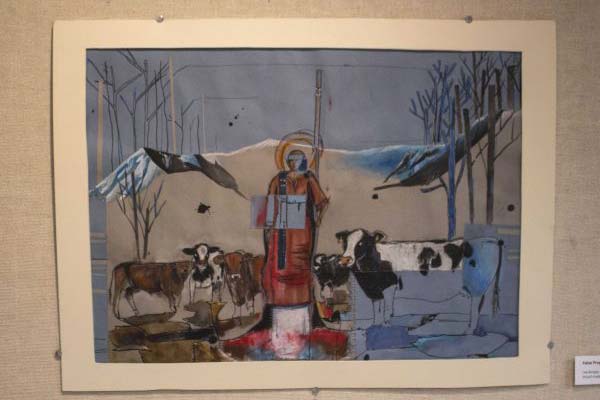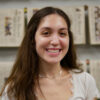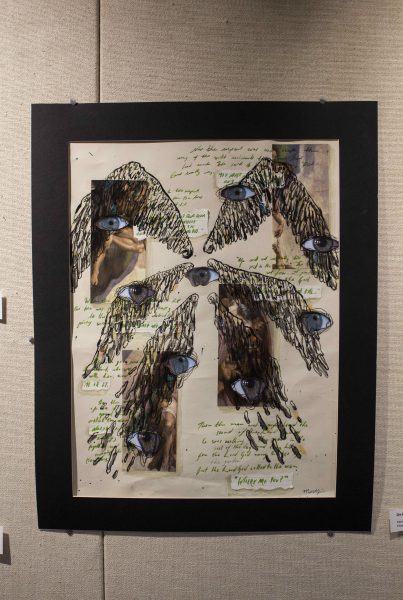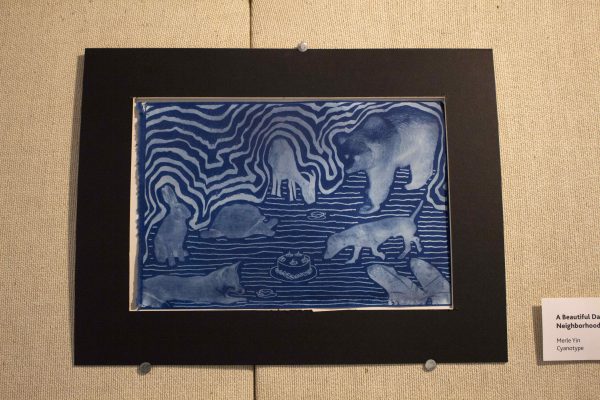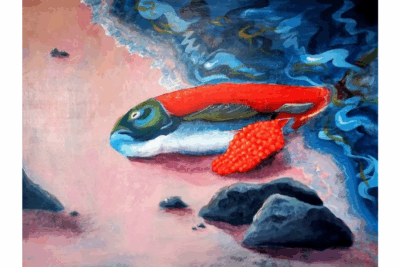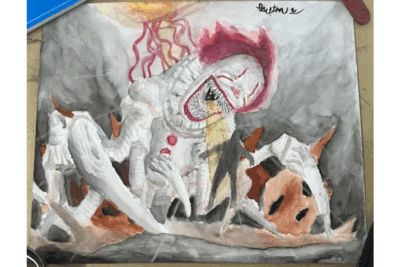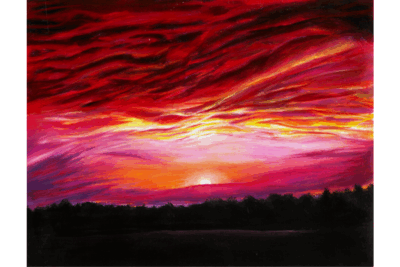Ten years ago, Randy Horst, professor of art, worked with art club members to propose the addition of a student exhibition to the Good Library basement gallery.
This year, the tradition continues with Goshen College’s latest art exhibition, titled Lion and Lamb. The gallery features ceramics, paintings, sculptures, photography and more – all created by Goshen College students.“We wanted more opportunit[ies] for students to get their work out there and for people to see it,” Horst said.
The next step in the process of creating an annual student exhibition was for the art department to choose several themes upon which exhibitions could be based.
“We tried to pick themes that not only resonated with things on campus but could also be interpreted broadly enough,” Horst said. “We came up with four of those that we cycle through … that way, students that are participating get a chance to do all four of them at some point during their academic career.”
This year’s theme — Lion and Lamb — emphasizes several of Goshen College’s core values. Horst notes the Biblical origins of the phrase, as well as the “connotation we tend to have in terms of peacemaking.”
The theme also encourages students to explore “diametric opposites” in their artwork.
“We often assume that the lion and lamb are opposites,” Horst said. “The whole idea is to [show that] the arts oftentimes embrace contradictions and … [are] a way of exploring something rather than just simply explaining it or proving a point. And part of what we wanted our students to do was to feel some of that freedom.”
The gallery features 81 works and represents 59 different student artists.
Merle Yin, a first year, has two pieces of art in the exhibit: “Do Not Fear” and “A Beautiful Day in the Neighborhood.”
“Do Not Fear” is a mixed media collage piece that Yin says “represents the contrast between the scary and the good sides of an angel.”
“Biblically speaking, physical depictions of angels have been rather otherworldly,” Yin said. “However, angels are messengers from God, bearing good news …when they descend from Heaven, angels will say ‘do not fear.’’’
In her piece, Yin portrays the Biblical appearance of angels through the incorporation of many eyes and large wings. These images are underlaid with lines of text, inspiring viewers to look closer and reflect on both the visual and textual aspects of the piece.
“The last line – ‘Where are you?’ – isn’t covered by parts of the angel wings,” Yin said. “[This encourages] the viewer to question where they are in their life and if they feel shameful or proud.”
Lee Bergey, a second year, chose to interpret the gallery theme as a “wolf in sheep’s clothing kind of idea.”
Bergey’s entry in the exhibition is a mixed media collage piece titled “False Prophets.”
“The prompt was Lion and Lamb, so I combined the two,” they said. “Lions are typically symbolic of a more dangerous power, and lambs are seen as a lot more gentle and innocent. Combining the two creates a dichotomy of power disguised [as] something innocent. I decided to depict this with the idea of false prophets – people who claim they have a higher truth, even though they don’t … a lot of people find comfort in following someone who they believe has the truth.”
Bergey used the concept of cows following a shepherd figure to represent this idea of “comfort” in their piece.
“Cows are kind, intelligent animals and can have a lot of individuality, but they’re still pack animals,” they said. “They need a leader. Much like sheep, they’ll follow anyone who offers them leadership, whether or not that person is safe or is holding their best interest. I think this kind of mirrors the idea of a false prophet.”
Bergey adds that this piece was extra fun because they happen to “like cows a lot.”
Esmeralda Bucio, a fourth year, used acrylic paint and printed images to create her piece, titled “Mutualistic Relationship of a Horse and Seahorses.”
“[The piece’s] narrative described the idea that in an alternative universe, land horses and seahorses developed a mutualistic relationship as an adaptation to global warming,” Bucio said.
“In terms of content, my piece communicates ideas within the themes of diametrical opposites and the animal kingdom. For example, I decided to include the horse and the seahorses due to their opposite qualities, such as one being aquatic and the other being terrestrial, one being noticeably bigger and the other smaller, and how even their reproduction differs.”
Annika Fisher, a first year, chose to focus on the animal kingdom aspect of the Lion and Lamb theme in her piece “Burger Night.” The cyanotype features cows and skeletons eating burgers.
“I think there is some shock factor in showing cows eating beef that makes it seem like meat shouldn’t be consumed, which I personally believe,” Fisher said.
Fisher’s other piece in the exhibit, a charcoal drawing titled “Captivating Captivity,” emphasizes the sharp contrast between two very different objects: a bear trap and a tutu.
Fisher notes that the two objects “reference items used to capture and show off bears in circuses” and that the overall meaning of the piece is that “people take advantage of the animal kingdom.”
Horst believes that it is important for students’ work to be represented in exhibits like the Lion and Lamb gallery because it gives “more of a completeness to the work.”
“Students have been practicing [these] skills all along,” Horst said, “but it doesn’t become fully real in a community way until it gets to that final step.”
Goshen College community members can see the artwork of Yin, Bergey, Bucio, Fisher and 55 other featured students in the basement gallery of the Good Library. The exhibition will be up until Feb. 28th.
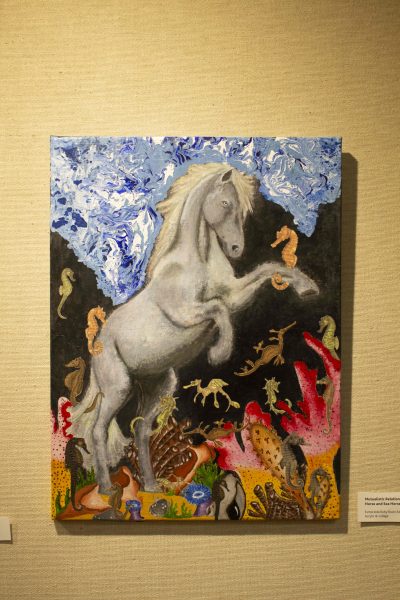 “Mutualistic Relationship of a Horse and Seahorses,” Esmeralda Bucio
“Mutualistic Relationship of a Horse and Seahorses,” Esmeralda Bucio
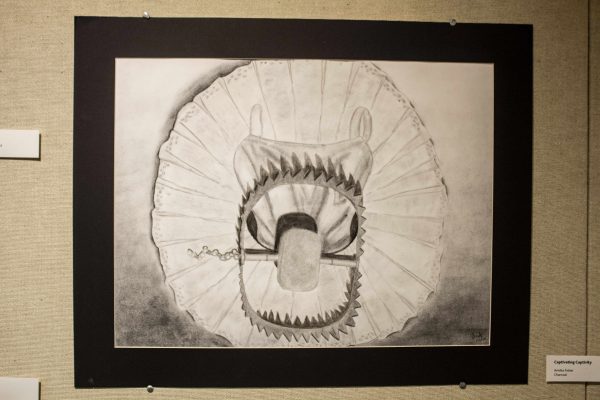 “Captivating Captivity,” Annika Fisher
“Captivating Captivity,” Annika Fisher
